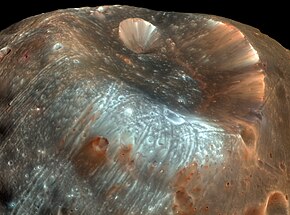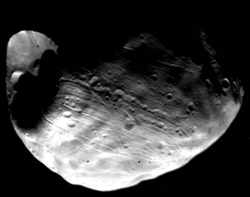 Heavily saturated false color image of Stickney with the smaller crater Limtoc within it, as seen by MRO on 23 March 2008. Heavily saturated false color image of Stickney with the smaller crater Limtoc within it, as seen by MRO on 23 March 2008. | |
| Feature type | Impact crater |
|---|---|
| Location | 1°N 49°W / 1°N 49°W / 1; -49 |
| Diameter | 9 km (5.6 mi) |
| Discoverer | Asaph Hall |
| Naming | Chloe Angeline Stickney Hall |

(Viking orbiter, 10 June 1977)
Stickney is the largest crater on Phobos, which is a satellite of Mars. It is 9 km (5.6 mi) in diameter, taking up a substantial proportion of the moon's surface.
Naming
The crater is named after mathematician Chloe Angeline Stickney Hall, the wife of Phobos' discoverer Asaph Hall, whose support was credited by her husband as critical for his discovery of the moon. The crater was named in 1973, based on Mariner 9 images, by an IAU nomenclature committee chaired by Carl Sagan.
Formation
There are two models for the age of Stickney, based on the differing possible dates at which Phobos began to orbit around Mars. If Phobos has been orbiting for 4.3 Ga (billion years) then Stickney formed 4.2 Ga ago, but if Phobos has only been orbiting for 3.5 Ga then it formed 2.6 Ga ago. The impact created a large amount of ejecta which escaped Phobos' gravity and entered into orbit around Mars for a period not exceeding 1000 years, some of this material then crashed back onto Phobos and created secondary impact craters. The majority of craters on Phobos that are smaller than 600 meters in diameter were caused by these secondary impacts.
Physical features
Grooves and crater chains appear to radiate from Stickney. One theory suggests that they were formed as a result of stresses from the impact that created the crater; if true this suggests that said impact nearly destroyed Phobos. There are however numerous other theories for how they were made, such as that they were formed by material ejected from impacts on Mars, that they were created by tidal forces exerted by Mars, or that they were created by boulders rolling along Phobos' surface following the Stickney impact.
Regardless of the causes of these grooves, the impact of the object which created Stickney was large enough to have potentially destroyed Phobos; a 2016 study by Syal et al. found that the high porosity of the moon was critical in preventing it from being destroyed during the collision. It is possible that the area underneath Stickney is much denser and less porous than the rest of Phobos, though models of the moon's interior vary on this.
Stickney has a noticeable lineated texture on its interior walls, caused by landslides from materials falling into the crater. There is a noticeable blue spectral coloration on the south-western edge of the crater, which is theorized to be a relatively thin layer of rock. Said coloration was likely caused by a combination of material from Stickney itself and from the smaller crater of Limtoc.
See also
References
- ^ "Planetary Names: Crater, craters: Stickney on Phobos". Gazetteer of Planetary Nomenclature. International Astronomical Union. November 29, 2006.
- Hall, Angelo (1908). An astronomer's wife. Baltimore: Nunn and Company. p. 112. OCLC 997037.
- Veverka, Joseph; et al. (1974). "A Mariner 9 atlas of the moons of Mars". Icarus. 23 (2). Elsevier: 206–289. Bibcode:1974Icar...23..206V. doi:10.1016/0019-1035(74)90006-2..
- Schmedermann, Nico; et al. (November 1, 2014). "The age of Phobos and its largest crater, Stickney". Planetary and Space Science. 102. Elsevier: 152–163. doi:10.1016/j.pss.2014.04.009. Retrieved August 9, 2022.
- Ramsley, Kenneth R.; Head, James W. (April 2017). "The Stickney Crater ejecta secondary impact crater spike on Phobos: Implications for the age of Stickney and the surface of Phobos". Planetary and Space Science. 138. Elsevier: 7–24. doi:10.1016/j.pss.2017.02.004. Retrieved August 12, 2022.
- Ramsley, Kenneth R.; Head, James W. (2019). "Stickney Crater: Secondary Impacts, Boulders, Grooves, and the Surface Age of Phobos" (PDF). Brown University (2132). 50th Lunar and Planetary Science Conference: 1. Retrieved August 24, 2022.
- Murray, John B.; et al. (2006). "New evidence on the origin of Phobos' parallel grooves from HRSC Mars Express" (PDF). Lunar and Planetary Science Conference. Lunar and Planetary Institute & Johnson Space Center.
- Zubritsky, Elizabeth (November 11, 2015). "Mars' Moon Phobos is Slowly Falling Apart". Goddard Space Flight Center. NASA. Retrieved November 11, 2015.
- Gough, Evan (20 November 2018). "Strange Grooves on Phobos Were Caused by Boulders Rolling Around on its Surface". Universe Today. Retrieved 21 November 2018.
- Ramsley, Kenneth R.; Head, James W. (16 November 2018). "Origin of Phobos grooves: Testing the Stickney Crater ejecta model". Planetary and Space Science. 165. Elsevier: 137–147. doi:10.1016/j.pss.2018.11.004. S2CID 86859432.
- Syal, Megan Bruck; et al. (October 8, 2016). "Excavating Stickney crater at Phobos". Geophysical Research Letters. 43 (20). American Geophysical Union: 10595–10601. doi:10.1002/2016GL070749. S2CID 131912268.
- Le Maistre, Simon; Rivoldini, Attilio; Rosenblatt, Pascal (March 15, 2019). "Signature of Phobos' interior structure in its gravity field and libration". Icarus. 321. Elsevier: 272–290. doi:10.1016/j.icarus.2018.11.022. S2CID 125563790. Retrieved August 15, 2022.
- "Phobos from 6,800 Kilometers (Color)". NASA. Jet Propulsion Laboratory & University of Arizona. April 9, 2008. Archived from the original on April 12, 2008. Retrieved April 9, 2008.
- Thomas, Nathan; et al. (October 2011). "Spectral heterogeneity on Phobos and Deimos: HiRISE observations and comparisons to Mars Pathfinder results". Planetary and Space Science. 59 (13). Elsevier: 1281–1292. doi:10.1016/j.pss.2010.04.018. Retrieved August 18, 2022.
- ^ Kikuchi, Hiroshi (January 15, 2021). "Simulating re-impacts from craters at the deepest location of Phobos to generate its blue spectral units". Icarus. 354. Elsevier: 113997. doi:10.1016/j.icarus.2020.113997. S2CID 224926793. Retrieved August 5, 2022.
External links
- Flight around Phobos (animated movie)
- Stickney in High Resolution
- Stickney at APOD, 2018 May 5
- Creation of Stickney Crater on Phobos (VIDEO) Archived 2018-09-14 at the Wayback Machine simulation which shows how Stickney crater was created, and how it affected Phobos, The Lawrence Livermore National Laboratory